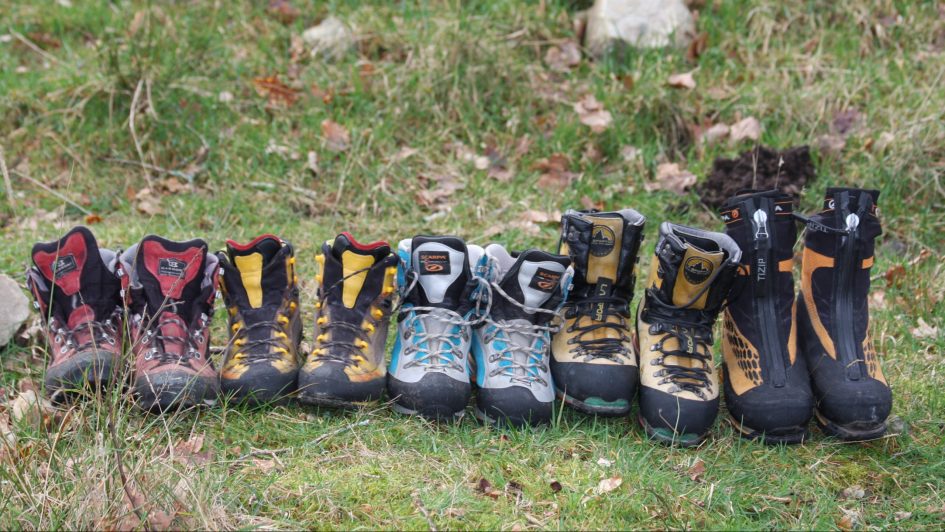Here we talk you through the main points to consider and things to look for when choosing these essential bits of winter kit.
Choosing the right winter boots and crampons can be confusing, particularly if you are looking for the first time!
Winter Boots
Winter boots come with a B rating; generally speaking, the higher the ‘B’ rating, the stiffer and warmer the boot will be. It also tells us what sort of crampons it will take.
B1 Boots

Are the most flexible boots that will still handle a full walking crampon. Generally speaking, they will not have huge amounts of insulation, and will be designed with trekking over mountaineering in mind, making them comfortable for walking below the snowline. Their flexibility however does limit their effectiveness in steeper terrain and can make kicking steps difficult. Examples include the Scarpa SL Activ and Meindl Himalaya. These boots will only take C1 crampons (see below for more on crampons).
B2 Boots

Are semi-stiff mountaineering boots, often with a ledge (called a welt) at the heel for attaching semi-automatic crampons. They offer better mountaineering and climbing ability, taking you comfortably into lower grade climbing terrain, have sharp edged soles for kicking into the snow, and are laterally supportive for crossing snow slopes. They are flexible enough to make walking up to the snowline a much more comfortable affair but will see you through a wide range of winter mountain terrain; a great choice and a good all-rounder. Examples include the Scarpa Manta, Mammut Magic High and Asolo Freney XT. These boots will take C1 and C2 crampons.
B3 Boots

Are as close to rigid as possible; they normally feature a welt at the heel and the toe for attaching fully step in crampons and have lots of insulation. These boots are specialised and generally designed with either technical climbing, year-round alpinism or high-altitude mountaineering in mind. As a result, they can be uncomfortable to walk in below the snowline and can be heavy compared to more flexible boots. Examples are the La Sportiva Nepal and Scarpa Mont Blanc. These boots will accept all types of crampon.
Over the years this rating system has blurred somewhat; as an example, there are lots of B2 rated boots on the market that are designed with technical alpine terrain in mind (think of the La Sportiva Trango Cube). These boots will take a clip on crampon, but are actually more flexible than a traditional B2 boot, and have little or no insulation, making them fairly uncomfortable in Scottish winter!
Here are some important things to bear in mind when choosing your boots:
What are you going to be doing?
It is worth spending a good amount of time considering what you are likely to be using your boots for. Are you getting these boots for occasional walks in the snow, or are you planning to do lots of walking and maybe some easy climbing?
Do you plan to do some Alpine mountaineering?
Choose a boot that will be most appropriate for the activities you have in mind; at some point there will be a level of compromise required. We recommended B2 boots as a generally good all rounder for lots of summer mountaineering as well as a wide range of winter activities.
Single or Double Boots
Winter boots generally come in a single or double construction. Single boots have a one piece upper and are constructed and look like traditional boots. These are the most appropriate for UK winter walking and climbing. Double boots normally have a removable insulated inner boot and a tough insulated outer, sometimes a plastic shell. Double boots tend to more than are required for winter in the UK, but are a good choice if heading up to very high altitude, or to the poles! Single boots will generally be appropriate for UK winter walking and climbing.
Get the Fit
Right Ultimately, you can get the ‘best’ winter boots money can buy, and they won’t be worth a penny to you if they don’t fit! Spend plenty of time trying on as many boots as possible, from lots of different brands. Visit lots of different stores and speak to as many people as possible. Send as much time as possible walking around the shop, on different angles and terrain. Aim to try on boots in the afternoon (when your feet have swollen to their greatest size) and make sure you wear the sort of socks you will wear on the hill. A good outdoor store will be able to provide a proper boot fitting service, so make the most of it!
Crampon Compatibility
Crampons come equipped with a handy fit guide just like boots; C1, C2 and C3.
C1 Crampons

Are flexible, have 10-12 points and generally need to be strapped to the front and back of the boot; they are the only crampons that a B1 boot will take.
C2 Crampons

Are more rigid and normally come with 12 points and a heel clip and a toe basket to attach them to your boots. C2 crampons are a good mix between climbing ability and walking comfort.
C3 Crampons

Are fully rigid, come with a range of points (from 11 – 14) and normally attach via a toe bail and a heel clip. These crampons are designed for climbing and are very technical. Often the front points are very aggressive, making it easy to trip over your own feet. While you can walk in them, its not ideal!
Round Up
Just as boots need to fit your feet, crampons will need to fit your boots. Make sure the fit works long before you hit the snowline; some manufacturers work better together than others, and some models are a better fit that others. If in doubt, get some help from a reputable outdoor store and an experienced sales assistant!
We hope some of these tips help you in your search for winter boots! We look forward to seeing you on the hill soon!



Leave a Reply